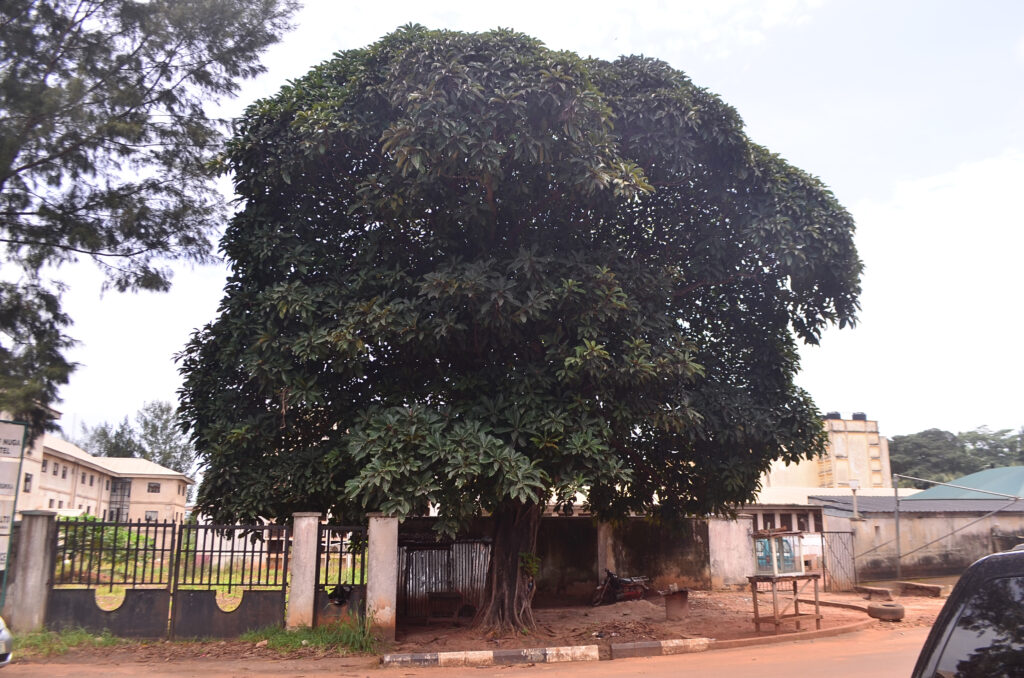A Tree’s Tongue

“A Tree’s Tongue” is part of the collection Indigenizing What It Means to Be Human. Read the introduction to the collection here.
A Tree’s Tongue
Chorus of our forebears
In the ground
Speaking with one voice through the Ogbodu tree
[1]
[1]
Ogbodu is a village in the Eha-Alumona clan of the Igbo of southeastern Nigeria. In October 2020, there was the news that a tree that had previously fallen and a large portion of its trunk sawed off rose again without any human effort. The tree is a short drive from the University of Nigeria, Nsukka, where I work. One of the graduate students in the sociology and anthropology department who hails from the town took me to the site of the event. I interviewed the oldest man in the community who, in this gerontocratic system, is at once the priest and leader in customary matters. I also interviewed eyewitnesses and took photographs. At a later date, when the community held a feast on the event, they invited me, and I went with some of my graduate students. The tree is of the populous Ficus genus and is called ọjẹ [ɔ̀dʒɛ̀] in the dialect of Igbo language spoken in Ogbodu. I sought the help of botanists at the university, but they have not been able to identify this particular species that can grow to an impressive size.
Using a writing coded in action nem. con.
[2]
[2]
Nem. con. is short for nemine contradicente, a Latin fixed phrase meaning “no one contradicting.”
Bidding those who are literate
In their sacred song: “Tell them,
‘We sure shall rise again;
As Mzee spake,
We shall rise again.’”
[3]
[3]
Mzee is Swahili for the “old man,” but Kenyans use the term to reverently refer to their former president, Jomo Kenyatta. Kenyatta, also a social anthropologist, had in his magnum opus on his Native Gikuyu (or Kikuyu) written, in anticipation of the African traditional religious rebound, “[T]he dead, the living, and the unborn will unite to rebuild the destroyed shrines.”
I֜ré ọ̀jẹ̀
Ihe ndi be anyị oge gbo
B́iźI n’ime ala
Ji ofuobi site n’osisi dị n’Ogbodu kwuo
[4]
[4]
Ogbodu bụ nkpụkpụ dị n’obodo Eha-Alumona só na mba ndi-Igbo nke dị֜ na Ǹdị̀dà ọwụwaanyanwụ Naijirịa. Onye jìri֜ moto ọ̀ ma-ewecha ya miniti iriatọ i֜sī na Mahadum Naiịiria ebe m na-alụ ọlụ rue ya. N’Ọkụtoba 2020 akụkọ bịara gbasaba na otu ukwuosisi daburu ada egbujisie ụfọdụ akụkụ ya kunitakwara ọzọ na-abụghị na mmadụ buliri ya. Otu n’ime ụmụakwụkwọ m nke na-agụ nke ọkwa dị elu ana-akpọ ọkwa grajuaeti nke bụ onye obodo ahụ kpọ̀rọ̀ m gaa ebe ihe ahụ mere. Agbara m nwoke kasị bụrụ okenye n’obodo ahụ ajụjụ ọnụ, onye bụkwazi onyendu n’ihe gbasara agọmmmọ nakwa ọchịchịobodo n’ụzọ ọdịnanị dịka ụsoroọchịchịokenye ebe ahụ si dị. Agbakwara m ndi nọ mgbe ihe ahụ mere ajụjụ ọnụ ma sekwaa foto. N’oge ọzọ mgbe ndi obodo ahụ mere mmemme maka ihe ahụ, ha kpọrọ m ka m soro ha m wee kpọrọ ụfọdụ n’ime ụmụakwụkwọ m nke ọkwa grajuaeti je. Osisi ahụ sò na jenus bara ụba ana-akpọ Ficus nke ndi obodo a nakpọkwanụ ọjẹ [ɔ̀dʒɛ̀] n’olu Igbo be ha. A yọrọ m ndi na-amụmaka osisi na mahadum mana ha aka-enwerọ ike ịchọpụta usoro spisisi nke osisi a na-ágbā àgbà ri nne bụ.
Ha ji ihe ha mere eme etinyere n’ihe ha derede ede kwuo n’otu olu
Gwa ndi maara ka esi àgụ́́ ụ֜dị̄ edemede ahụ
Etinyere n’abụ nsọ ha: “Gwanụ̀ ha,
“Anyị ga-ekunitarịrị ọzọ;
“Dịka Mzee siri kwu,
[5]
[5]
Mzee bụ okwu Swahili maka “agadi nwoke” mana yanwa ka ndi-Kenya na-akpọ onye bụbu onyeisiala ha, Jomo Kenyatta, n’ụdị nkwanyeugwu. Kenyatta bụ́kwazi onyeantrọpọlọji bụ maka ndi agbụrụ ya ana-akpọ Gikuyu (maọbụ Kikuyu) ka o dere akwụkwọ ya kachasị nkpa nke o dere iji gosị atụmaanya ya maka mgbe agọmmmọ ndi-Afrika n’ụdị ọdịnana ga-alọghachita. “Ndi nwụrụ anwụ, ndi dị ndụ, nakwa ndi akaejekọ ịmụ ga-ejikọ aka ọnụ wughachi ebe ndi ahụ ana-anọ agọ mmọ etikpọsịrị.” (Kenyatta, J. (1938/1978) Facing Mount Kenya. London na Nairobi: Martin Secker & Warburg Ltd maka nke ebipụtara na 1938; Kenway Publications maka nke epipụtara na 1978, ibe akwụkwụ, vi).
“Anyị ga-ekunita ọzọ.”

































